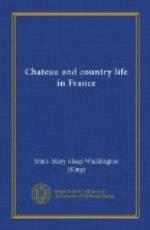We left the auto at the hotel and found many others in the court-yard, and various friends. The d’Y——s had come over from Grangues (their place). He is Conseiller General of Calvados, and market day, in a provincial town, is an excellent occasion for seeing one’s electors. There were also some friends from Trouville-Deauville, most of them in autos—some in light carriages. We tried to make a rendezvous for tea at the famous patissier’s (who sends his cakes and bonbons over half the department), but that was not very practical, as they had all finished what they had to do and we had not even begun our sightseeing. However, d’Y—— told us he would leave our names at the tea-room, a sort of club they have established over the patissier’s, where we would be quieter and better served than in the shop which would certainly be crowded on Saturday afternoon. We walked about till we were dead tired.
St. Pierre is a fine old Norman church with beautiful tower and steeple. It stands fairly well in the Place St. Pierre, but the houses are much too near. It should have more space around it. There was a market going on, on the other side of the square—fruit, big apples and pears, flowers and fish being heaped up together. The apples looked tempting, such bright red ones.
We went to the two abbayes—both of them quite beautiful—St. Etienne—Abbaye aux Hommes was built by William the Conqueror, who was originally buried there. It is very grand—quite simple, but splendid proportions—a fitting resting-place for the great soldier, who, however, was not allowed to sleep his last sleep, undisturbed, in the city he loved so well. His tomb was desecrated several times and his remains lost in the work of destruction.
We went on to the Abbaye aux Dames which is very different; smaller—not nearly so simple. The facade is very fine with two square towers most elaborately carved, the steeples have long since disappeared; and there are richly ornamented galleries and balustrades in the interior of the church, not at all the high solemn vaulted aisles of the Abbaye aux Hommes. It was founded by Queen Mathilde, wife of William the Conqueror, and she is buried there—a perfectly simple tomb with an inscription in Latin. There was at one time a very handsome monument, but it was destroyed, like so many others, during the Revolution, and the remains placed, some years after, in the stone coffin where they now rest. We hadn’t time to see the many interesting things in the churches and in the town, as it was getting late and we wanted some tea before we started back. We found our way to the patissier’s quite easily, but certainly couldn’t have had any tea if d’Y—— had not told us to use his name and ask for the club-room. The little shop was crowded—people standing and making frantic dashes into the kitchen for chocolate and muffins. The club-room upstairs was quite nice—painted white, a good glass so that we could arrange our hair a little, one or two tables—and we were attended to at once. They brought us the specialite of the place—light, hot brioches with grated ham inside—very good and very indigestible.




